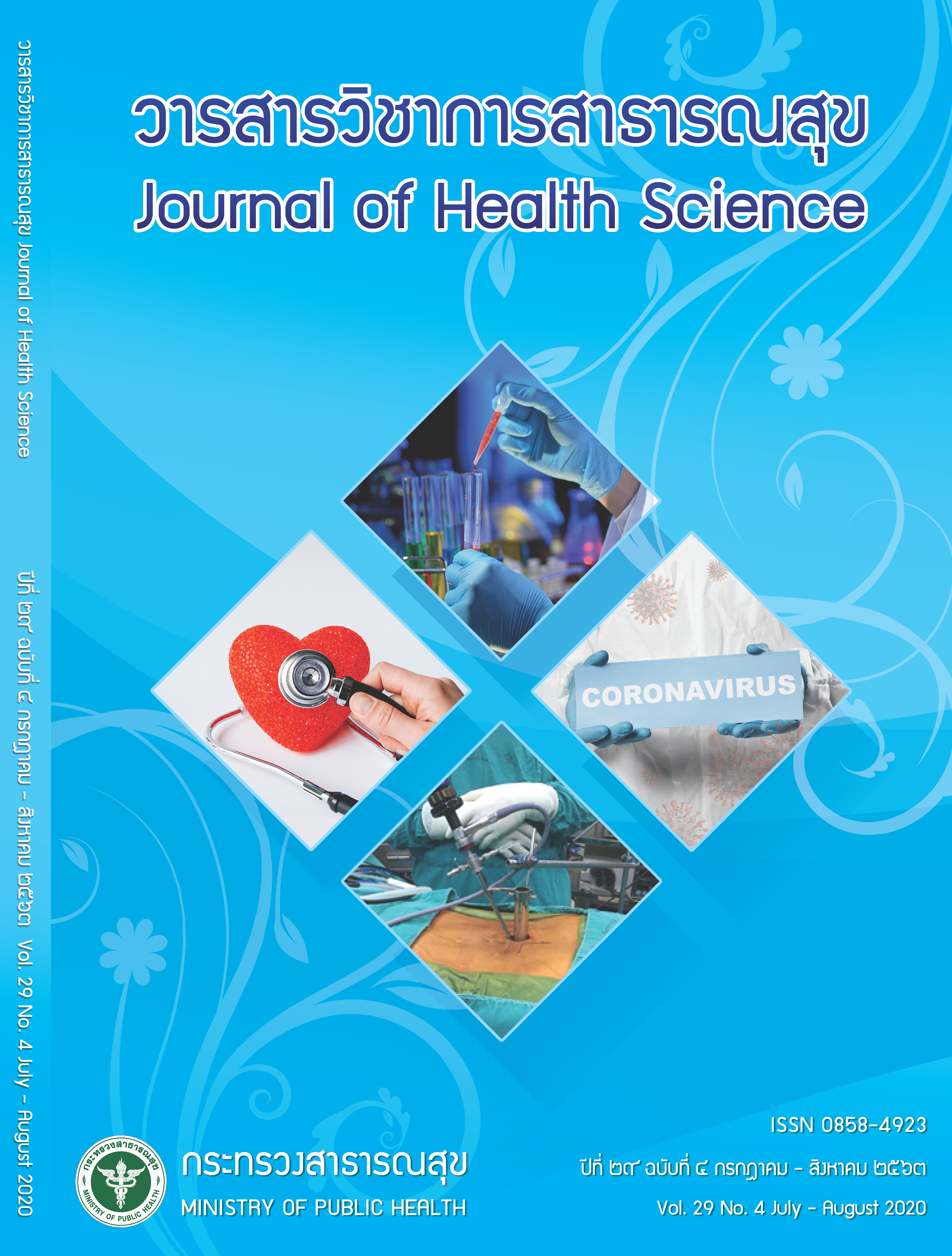4-Quadrant Multisectoral Collaboration Model for the Prevention and Control of NCDs
Keywords:
noncommunicable disease, model, multisectoral, network, prevention and control, ThailandAbstract
Noncommunicable diseases (NCDs), defined by the World Health Organization as cardiovascular diseases, cancers, diabetes mellitus, and chronic pulmonary diseases; and their main risk factors, which include tobacco smoking, alcohol drinking, unhealthy diet, and inadequate physical activity levels, contribute significantly to the burden of disease in Thailand, and globally. The prevention and control of NCDs and their risk factors in Thailand cannot solely rely on the efforts of the Ministry of Public Health— it urgently requires multisectoral collaborative actions. The authors propose the 4-Quadrant (4QM) Model and five strategies to enhance multisectoral action for the prevention and control of NCDs. The 4QM model involves stakeholders from the Ministry of Public Health, the broader government, and the public. According to this model, there are four major parties: (1) the Formal System-Implementation Group, (2) the Informal System-Implementation Group, (3) the Formal System-Improvement Group, and (4) the Informal System-Improvement Group. The Formal System-Implementation Group includes the Ministry of Public Health and all governmental organizations. The Informal System-Implementation Group covers all individuals and organizations that are not governmental agencies. The Formal System-Improvement Group is comprised of funding agencies and international organizations. The Informal System-Improvement Group consists of networks of academicians. The 4QM will be able to inclusively enroll all stakeholders and unleash their potential in the prevention and control of NCDs. The five strategies proposed to enhance the multisectoral collaborative action include: (1) the Collective Leadership Strategy, (2) the Knowledge Management Strategy, (3) the Networking and Advocacy Strategy, (4) the Professional Central Management Strategy, and (5) the Top-leader Advocacy Strategy. Thailand can achieve its SDGs accordingly if its stakeholders employ the proposed model and strategies.
Downloads
References
World Health Organization. Noncommunicable diseases: country profiles 2018. Geneva: World Health Organi-zation; 2018.
Engelgau M, Rosenhouse S, El-Saharty S, Mahal A. The economic effect of noncommunicable diseases on house-holds and nations: a review of existing evidence. J Health Commun 2011;16(Suppl 2):75–81.
World Health Organization. Global status report on non-communicable diseases 2014. Geneva: World Health Organization; 2014.
สถาบันวิจัยระบบสุขภาพ. BOD: ระบบข้อมูลภาระโรค [อินเทอร์เน็ต]. [สืบค้นเมื่อ 28 เม.ย. 2563]. แหล่งข้อมูล: https://www.hiso.or.th/bodproject/
แผนงานการพัฒนาดัชนีภาระทางสุขภาพเพื่อการพัฒนานโยบาย. รายงานภาระโรคจากปัจจัยเสี่ยงของประชากรไทย พ.ศ. 2557. นนทบุรี: มูลนิธิเพื่อการพัฒนานโยบายสุขภาพระหว่างประเทศ; 2561.
สำนักงานพัฒนานโยบายสุขภาพระหว่างประเทศ. รายงานภาระโรคและการบาดเจ็บของประเทศไทย พ.ศ. 2557. นนทบุรี: มูลนิธิเพื่อการพัฒนานโยบายสุขภาพระหว่างประเทศ; 2560.
World Health Organization. 2008-2013 action plan for the global strategy for the prevention and control of non-communicable diseases: prevent and control cardio-vascular diseases, cancers, chronic respiratory diseases and diabetes. Geneva: World Health Organization; 2008.
World Health Organization. Global action plan for the prevention and control of noncommunicable diseases 2013-2020. Geneva: World Health Organization, 2013.
World Health Organization. Noncommunicable diseases progress monitor, 2015. Geneva: World Health Organi-zation; 2015.
World Health Organization. Noncommunicable diseases progress monitor, 2017. Geneva: World Health Organi-zation; 2017.
สำนักงานคณะกรรมการเศรษฐกิจและสังคมแห่งชาติ กระทรวงสาธารณสุข, มหาวิทยาลัยมหิดล. แผนยุทธศาสตร์สุขภาพดีวิถีชีวิตไทย พ.ศ. 2554-2563. นนทบุรี: กระทรวง-สาธารณสุข; 2553.
สำนักงานกองทุนสนับสนุนการสร้างเสริมสุขภาพ. ทิศทาง เป้าหมาย และยุทธศาสตร์ ระยะ 10 ปี (2555-2564). กรุงเทพมหานคร: สำนักงานกองทุนสนับสนุนการสร้างเสริมสุขภาพ; 2554.
กลุ่มยุทธศาสตร์และแผนงาน. แผนยุทธศาสาตร์การป้องกันและควบคุมโรคไม่ติดต่อเรื้อรังระดับชาติ 5 ปี (พ.ศ. 2560-2564). นนทบุรี: สำนักโรคไม่ติดต่อ กระทรวงสาธารณสุข; 2560.
ศิริวรรณ ทิพยรังสฤษฎ์, บรรณาธิการ. รายงานสถานการณ์โรค NCDs: kick off to the goals. นนทบุรี: สำนักงานพัฒนานโยบายสุขภาพระหว่างประเทศ; 2559.
พระราชบัญญัติควบคุมผลิตภัณฑ์ยาสูบ พ.ศ. 2535. ราชกิจ-จานุเบกษา เล่มที่ 109, ตอนที่ 38 (ลงวันที่ 5 เมษายน 2535).
พระราชบัญญัติคุ้มครองสุขภาพผู้ไม่สูบบุหรี่ พ.ศ. 2535. ราชกิจจานุเบกษา เล่มที่ 109, ตอนที่ 40 (ลงวันที่ 7 เมษายน 2535).
กรมควบคุมโรค. แผนยุทธศาสตร์การควบคุมยาสูบแห่งชาติ ฉบับที่สอง พ.ศ. 2559-2562. นนทบุรี: กรมควบคุมโรค; 2559.
พระราชบัญญัติควบคุมผลิตภัณฑ์ยาสูบ พ.ศ. 2560. ราชกิจ-จานุเบกษา เล่มที่ 134, ตอนที่ 39 ก (ลงวันที่ 5 เมษายน 2560).
พระราชบัญญัติควบคุมเครื่องดื่มแอลกอฮอล์ พ.ศ. 2551.ราชกิจจานุเบกษา เล่มที่ 125, ตอนที่ 33 ก (ลงวันที่ 13 กุมภาพันธ์ 2551).
กรมควบคุมโรค. ยุทธศาสตร์นโยบายแอลกอฮอล์ระดับชาติ. นนทบุรี: กรมควบคุมโรค; 2559.
คณะกรรมการอาหารแห่งชาติ. กรอบยุทธศาสตร์การจัดการด้านอาหารของประเทศไทย. นนทบุรี: สำนักงานคณะ-กรรมการอาหารและยา กระทรวงสาธารณสุข; 2556.
กรมควบคุมโรค. ยุทธศาสตร์ลดการบริโภคเกลือและโซเดียมในประเทศไทย ปี พ.ศ. 2559-2568. กรุงเทพมหานคร: องค์การสงเคราะห์ทหารผ่านศึก; 2559.
พระราชบัญญัติควบคุมการส่งเสริมการตลาดอาหารสำหรับทารกและเด็กเล็ก. ราชกิจจานุเบกษา เล่มที่ 134, ตอนที่ 72 ก (ลงวันที่ 10 กรกฎาคม 2560).
กระทรวงสาธารณสุข. ประกาศกระทรวงสาธารณสุข เลขที่388 พ.ศ. 2561 เรื่อง กำหนดอาหารที่ห้ามผลิต นำเข้า หรือจำหน่าย. ราชกิจจานุเบกษา เล่มที่ 135, ตอนที่ 166 ง (ลงวันที่ 13 กรกฎาคม 2561).
กรมอนามัย. แผนแม่บทการส่งเสริมกิจกรรมทางกาย. นนทบุรี: กรมอนามัย; 2561.
พระราชบัญญัติภาษีสรรพสามิต พ.ศ. 2560. ราชกิจจานุเบกษา เล่มที่ 134, ตอนที่ 32 ก (ลงวันที่ 20 มีนาคม 2560).
World Health Organization. Contributing to social and economic development: sustainable action across sectors to improve health and health equity (follow-up of the 8thGlobal Conference on Health Promotion): report of the Secretariat. (Provisional agenda item 14.5, A68/17, 18 May 2015) [Internet]. [cited 2020 Apr 18]. Available from: https://apps.who.int/gb/ebwha/pdf_files/WHA68/A68_17-en.pdf
World Health Organization. Approaches to establishing country-level, multisectoral coordination mechanisms for the prevention and control of noncommunicable diseases. New Delhi: World Health Organization – Regional Office for South-East Asia; 2015.
Ramaboot S, Ungchusak K, Rousseau S, Shuey D. Final evaluation of WHO country cooperation strategy, Thailand 2012-2016. Nonthaburi: World Health Organization Thailand; 2016.
Joint Mission of the United Nations Interagency Task Force on the Prevention and Control of Noncommunica-ble Diseases, Thailand, 20-30 August 2018. Geneva: World Health Organization; 2018.
Bechervaise C. 5 reasons why vision is important in leadership [Internet]. [cited 2020 Apr 17]. Available from: https://takeitpersonelly.com/2013/10/14/5-reasons-why-vision-is-important-in-leadership/
Heathfield SM. Leadership vision: you can’t be a real leader who people want to follow without vision [Internet]. [cited 2020 Apr 17]. Available from: https://www.thebalancecareers.com/leadership-vision-1918616
Abrell-Vogel C, Rowold J. Leaders’ commitment to change and their effectiveness in change – a multilevel investigation. Journal of Organizational Change Manage-ment 2014;27(6):900-21.
สำนักเลขาธิการนายกรัฐมนตรี. ทำเนียบนายกรัฐมนตรี. [อินเทอร์เน็ต]. [สืบค้นเมื่อ 19 เม.ย. 2563]. แหล่งข้อมูล: https://www.thaigov.go.th/aboutus/history/index
วิกิพีเดีย. รัฐมนตรีว่าการกระทรวงสาธารณสุขของไทย [อินเทอร์เน็ต]. [สืบค้นเมื่อ 19 เม.ย. 2563]. แหล่งข้อมูล: https://th.wikipedia.org/wiki/รัฐมนตรีว่าการกระทรวง-สาธารณสุขของไทย
Wilson R. Collective leadership – the what, why, and how [Internet]. [cited 2020 Apr 19]. Available from: https://growingorganisations.com/wp-content/uploads/2018/08/blog-collective-leadership-the-what-why-and-how.pdf
Friedrich TL, Vessey WB, Schuelke MJ, Ruark GA, Mumford MD. A framework for understanding collective leadership: the selective utilization of leader and team expertise within networks. Leadership Quarterly 2009; 20(6):933-58.
Friedrich TL, Griffith JA, Mumford MD. Collective leadership behaviors: evaluating the leader, team network, and problem situation characteristics that influence their use. Leadership Quarterly 2016;27(2):312-33.
Bono ED. Teach your child how to think. London: Pen-guin Books; 1994.
MGR Online. เครือข่ายงดเหล้า-ผู้หญิง จี้คมนาคม สังคยนารถไฟห้ามขายเครื่องดื่มแอลกอฮอล์ ปิดช่องขี้เมาก่อเหตุ [อินเทอร์เน็ต]. 9 กรกฎาคม 2557 [สืบค้นเมื่อ 29 เม.ย. 2563]. แหล่งข้อมูล: https://m.mgronline.com/qol/detail/9570000077484
ปาริชาต ศิวะรักษ์. กำเนิดกองทุน สสส. (พิมพ์ครั้งที่ 3). กรุงเทพมหานคร: สำนักงานกองทุนสนับสนุนการสร้าง-เสริมสุขภาพ; 2556.
Covey SR. The 7 habits of highly effective people. Coral Gables, FL: Mango Media Inc; 2015.
Wasi P. Triangle that moves the mountain and health systems reform movement in Thailand. Bangkok: Health Systems Research Institute; 2000.
Downloads
Published
How to Cite
Issue
Section
License

This work is licensed under a Creative Commons Attribution-NonCommercial-NoDerivatives 4.0 International License.







